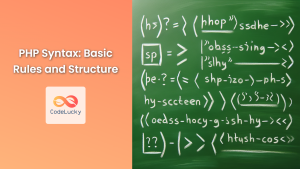In the world of PHP development, efficiency and code organization are paramount. Two powerful tools that help achieve these goals are the include and require statements. These functions allow developers to incorporate external PHP files into their scripts, promoting code reusability and maintainability. In this comprehensive guide, we’ll dive deep into the world of include and require, exploring their similarities, differences, and best practices for implementation.
Understanding Include and Require
Both include and require serve the same primary purpose: they allow you to insert the content of one PHP file into another. This functionality is incredibly useful for several reasons:
- 🔄 Code reusability
- 📁 Better organization of code
- 🛠️ Easier maintenance
- 🚀 Improved performance through caching
Let’s start by looking at the basic syntax for both statements:
include 'filename.php';
require 'filename.php';
While they may look identical at first glance, there’s a crucial difference in how they handle errors.
The Key Difference: Error Handling
The main distinction between include and require lies in how they respond when the specified file cannot be found:
- 🚨
includewill generate a warning (E_WARNING) and continue script execution - 🛑
requirewill generate a fatal error (E_COMPILE_ERROR) and halt script execution
This difference makes require more suitable for including critical files that are absolutely necessary for your script to function properly.
Let’s demonstrate this with an example:
<?php
// Using include
echo "Before include\n";
include 'non_existent_file.php';
echo "After include\n";
// Using require
echo "Before require\n";
require 'non_existent_file.php';
echo "After require\n";
?>
Output:
Before include
Warning: include(non_existent_file.php): Failed to open stream: No such file or directory in /path/to/script.php on line 3
Warning: include(): Failed opening 'non_existent_file.php' for inclusion (include_path='.:') in /path/to/script.php on line 3
After include
Before require
Fatal error: require(): Failed opening required 'non_existent_file.php' (include_path='.:') in /path/to/script.php on line 7
As you can see, the script continues execution after the include statement, while it halts at the require statement.
Include_once and Require_once
PHP also provides include_once and require_once variants. These functions work similarly to their counterparts but with an added check to ensure that the file is only included once, even if the include statement is executed multiple times.
This is particularly useful when working with function or class definitions to avoid redeclaration errors.
Let’s look at an example:
<?php
// file: functions.php
function greet($name) {
echo "Hello, $name!\n";
}
// file: main.php
include_once 'functions.php';
include_once 'functions.php'; // This won't cause any issues
greet("Alice");
greet("Bob");
?>
Output:
Hello, Alice!
Hello, Bob!
In this example, even though we include the functions.php file twice, the greet function is only defined once, avoiding any potential errors.
Best Practices for Using Include and Require
To make the most of these powerful functions, consider the following best practices:
-
🔒 Use
requirefor critical files: If your script cannot function without a particular file, userequireto ensure that any issues are caught immediately. -
🔄 Use
include_onceorrequire_oncefor files containing function or class definitions: This prevents accidental redefinitions. -
📁 Organize your includes: Keep your included files in a dedicated directory for better organization.
-
🛡️ Use absolute paths: When possible, use absolute paths to avoid issues with relative paths when your script is run from different locations.
-
🚫 Don’t include files with sensitive information: Be cautious about including files that contain sensitive data like database credentials.
Let’s see these practices in action with a more complex example:
<?php
// config.php
define('DB_HOST', 'localhost');
define('DB_USER', 'username');
define('DB_PASS', 'password');
define('DB_NAME', 'mydb');
// functions.php
function connectDB() {
$conn = new mysqli(DB_HOST, DB_USER, DB_PASS, DB_NAME);
if ($conn->connect_error) {
die("Connection failed: " . $conn->connect_error);
}
return $conn;
}
function getAllUsers($conn) {
$result = $conn->query("SELECT * FROM users");
return $result->fetch_all(MYSQLI_ASSOC);
}
// main.php
require_once __DIR__ . '/config.php';
require_once __DIR__ . '/functions.php';
$conn = connectDB();
$users = getAllUsers($conn);
echo "<table border='1'>
<tr>
<th>ID</th>
<th>Name</th>
<th>Email</th>
</tr>";
foreach($users as $user) {
echo "<tr>";
echo "<td>" . $user['id'] . "</td>";
echo "<td>" . $user['name'] . "</td>";
echo "<td>" . $user['email'] . "</td>";
echo "</tr>";
}
echo "</table>";
$conn->close();
?>
In this example, we’ve separated our configuration, functions, and main script into different files. We use require_once to include the critical files, and we’ve used absolute paths with __DIR__ to ensure the files can be found regardless of where the script is run from.
Performance Considerations
While include and require are incredibly useful, it’s important to be aware of their impact on performance. Each time you include a file, PHP needs to read and parse it, which can add up if you’re including many files or if the included files are large.
To mitigate this, consider the following strategies:
-
🚀 Use opcode caching: Opcode caches like OPcache can significantly improve performance by caching the compiled form of PHP scripts.
-
📦 Combine files: If you have many small files that are always used together, consider combining them into a single file.
-
🔍 Only include what you need: Be selective about what you include. Don’t include files with functions that aren’t used in the current script.
Conclusion
The include and require statements are powerful tools in the PHP developer’s toolkit. They allow for better code organization, improved maintainability, and enhanced reusability. By understanding the differences between these functions and following best practices, you can write more efficient and robust PHP applications.
Remember, the key to mastering these functions lies in practice. Experiment with different scenarios, try organizing your code in various ways, and you’ll soon find the approach that works best for your projects.
Happy coding, and may your PHP adventures be filled with perfectly included files and error-free requires! 🚀🐘



















